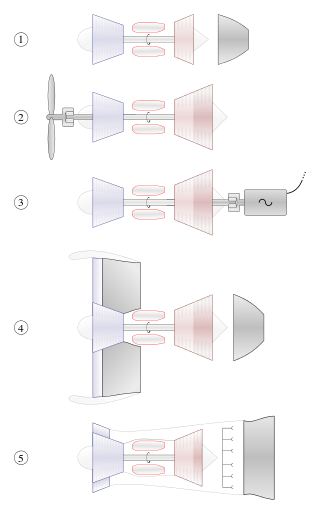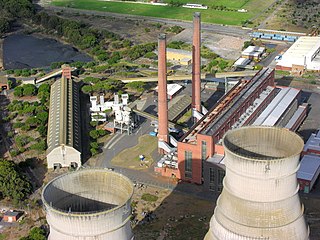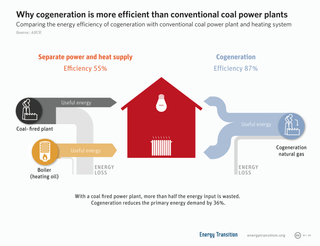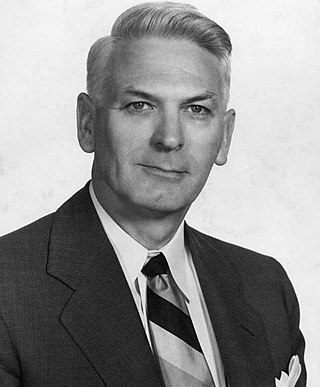
A gas turbine, gas turbine engine, or also known by its old name internal combustion turbine, is a type of continuous flow internal combustion engine. The main parts common to all gas turbine engines form the power-producing part and are, in the direction of flow:

A power station, also referred to as a power plant and sometimes generating station or generating plant, is an industrial facility for the generation of electric power. Power stations are generally connected to an electrical grid.

Tidal power or tidal energy is harnessed by converting energy from tides into useful forms of power, mainly electricity using various methods.

A combined cycle power plant is an assembly of heat engines that work in tandem from the same source of heat, converting it into mechanical energy. On land, when used to make electricity the most common type is called a combined cycle gas turbine (CCGT) plant, which is a kind of gas-fired power plant. The same principle is also used for marine propulsion, where it is called a combined gas and steam (COGAS) plant. Combining two or more thermodynamic cycles improves overall efficiency, which reduces fuel costs.

An underground power station is a type of hydroelectric power station constructed by excavating the major components from rock, rather than the more common surface-based construction methods.

Cogeneration or combined heat and power (CHP) is the use of a heat engine or power station to generate electricity and useful heat at the same time.

The Chernobyl Nuclear Power Plant (ChNPP) is a nuclear power plant undergoing decommissioning. ChNPP is located near the abandoned city of Pripyat in northern Ukraine, 16.5 kilometers (10 mi) northwest of the city of Chernobyl, 16 kilometers (10 mi) from the Belarus–Ukraine border, and about 100 kilometers (62 mi) north of Kyiv. The plant was cooled by an engineered pond, fed by the Pripyat River about 5 kilometers (3 mi) northwest from its juncture with the Dnieper river.

Peaking power plants, also known as peaker plants, and occasionally just "peakers", are power plants that generally run only when there is a high demand, known as peak demand, for electricity. Because they supply power only occasionally, the power supplied commands a much higher price per kilowatt hour than base load power. Peak load power plants are dispatched in combination with base load power plants, which supply a dependable and consistent amount of electricity, to meet the minimum demand.

A thermal power station is a type of power station in which heat energy is converted to electrical energy. In a steam-generating cycle heat is used to boil water in a large pressure vessel to produce high-pressure steam, which drives a steam turbine connected to an electrical generator. The low-pressure exhaust from the turbine enters a steam condenser where it is cooled to produce hot condensate which is recycled to the heating process to generate more high pressure steam. This is known as a Rankine cycle.

Penny's Bay Power Station is a gas turbine power station in Penny's Bay, Hong Kong. The HKD 1.1 billion power station was commissioned on 25 March 1992. The complex consists of three open cycle gas turbines in a rectangular turbine hall with three smokestacks. The turbines were supplied by John Brown Engineering and generators by GEC-Alsthom. It is operated by CLP Power as a standby and peaking power station. The power plant can start up in 12 minutes. Its primary fuel is ultra low sulphur diesel (ULSD).

The turbine hall, generating hall or turbine building is a building or room in any steam cycle or hydroelectric power plant which houses a number of components vital to the generation of electricity from the steam that comes from the boiler, or from the water coming from the reservoir. The components in the turbine hall typically are the turbines and electric generators, and in the case of steam cycle plants, moisture separators and reheaters. A turbine hall is typically extremely loud, and in the case of steam cycle plants, hot.
A load-following power plant, regarded as producing mid-merit or mid-priced electricity, is a power plant that adjusts its power output as demand for electricity fluctuates throughout the day. Load-following plants are typically in between base load and peaking power plants in efficiency, speed of start-up and shut-down, construction cost, cost of electricity and capacity factor.

The Silahtarağa Power Station was a coal-fired generating station located in Istanbul Turkey. The Ottoman Empire's first urban-scaled power plant, it was in use from 1914 to 1983. The site has since been converted into a university campus for the Istanbul Bilgi University and houses two museums and several facilities. It was refurbished and renamed SantralIstanbul in 2007.

The Sayano-Shushenskaya Dam is located on the Yenisei River, near Sayanogorsk in Khakassia, Russia. It is the largest power plant in Russia and the 12th-largest hydroelectric plant in the world, by average power generation. The full legal name of the power plant, OJSC [Open Joint-Stock Society] P. S. Neporozhny Sayano-Shushenskaya HPP [hydro power plant], refers to the Soviet-time Minister of Energy and Electrification Pyotr Neporozhny. As of 2009 the head of the power plant was Valery Kyari.

Pembroke Power Station is a 2,200 MWe natural gas-fired power station near Pembroke in Wales. The power station was officially opened in September 2012 and is the largest gas-fired power station in Europe. It is also the largest power station to be built in the UK since Drax power station came online in 1986. Pembroke Power Station currently generates enough power to supply 3.5 million homes and businesses. It is operated by RWE.

On 17 August 2009, a turbine in the hydroelectric power station of the Sayano-Shushenskaya Dam near Sayanogorsk in Russia failed catastrophically, killing 75 people and severely damaging the plant. The turbine hall was flooded, and a section of its roof collapsed. All but one of the ten turbines in the hall were destroyed or damaged. The entire power output of the plant, totalling 6,400 megawatts, was lost, leading to widespread power outages in the area. An official report on the accident was released in October 2009.

NTPC Ramagundam, a part of National Thermal Power Corporation, is a 2,600 megawatt (MW) Super thermal power station situated at Ramagundam in Peddapalli district in Telangana, India. It is the current largest power station in South India. It is the first ISO 14001 certified "Super Thermal Power Station" in India.
Doosan Škoda Power is a manufacturer and supplier of equipment for power stations, machine rooms especially equipped for steam turbines. Its headquarters are in Plzeň, Czech Republic. The portfolio includes steam turbines in the range of performances from 10 to 1200 MW in applications of gas, coal, cogeneration, nuclear and CSP power productions. Since 2009, it is part of the South Korean company Doosan. It has a significant position on the market, supplying its products to the US, Japan etc.

Robert Thomas Sawyer was the inventor of the first successful gas turbine locomotive.
















